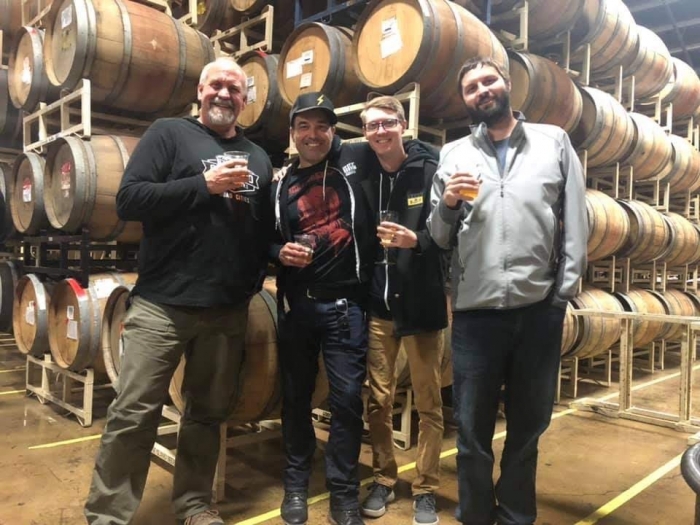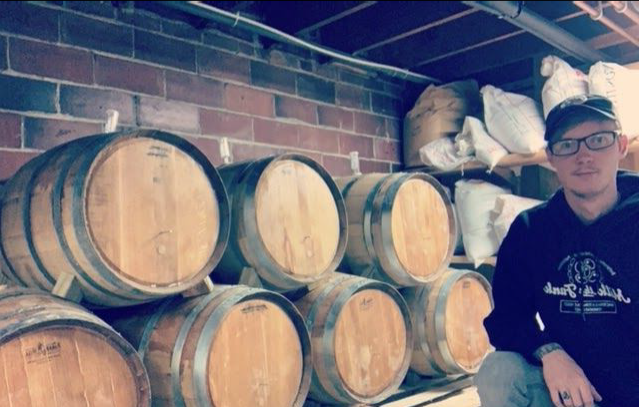Barrel Aged Beers of the Quad Cities
For years beer enthusiasts all over the country have rushed to their local supermarket and convenience stores on Black Friday in hopes of snagging a few bottles of the infamous “Bourbon County Brand Stout” made by Goose Island Brewing Company, a Chicago-based former craft brewery now owned by the Belgian mega-corporation AB-InBev. The stout is a thick and rich dark ale that has been aged in used barrels that once held bourbon. It is sold in fancy pint sized bottles and packs between 13% and 14% alcohol by volume. The brand once held a notorious reputation for being scarce and elusive in the market before the corporate buyout and an unfortunate “infection” problem in 2015. But brewers and beer enthusiasts alike can still attest that the Bourbon County popularity sparked the bourbon barrel-aged beer style trend that still remains popular to this day and continues on with local Quad Cities breweries. (Find out who has them right now.)
SO WHAT'S THE HYPE?
What makes barrel-aged beer worth the often hefty price tag? There are several reasons, but here are just a few:
Alcohol:
Barrel-aged beers are often much higher in ABV than standard beer sold in the market. This is done on purpose by breweries often to sell the “premium” price tag. While It’s actually not uncommon to see lower ABV styles aged in used spirit barrels, by far the most common products are high alcohol by volume stouts aged in bourbon barrels. The higher the ABV of a beer, the more malt was used in the beer. Malt is expensive for breweries. Thus, the higher the ABV, the more a brewery must charge to make it financially worth it. But does the high alcohol come from the spirit the barrel once aged? We’ll get to that a bit later.
Package:
Barrel-aged products are most commonly found in a “premium” package. Usually a single, larger format, bottle as opposed to the 16oz aluminum can that has become the most common package in the market. Special bottles, labels, sometimes wax dipped, and often hand-filled individually is expensive for any brewery. This all needs to be made up in the price. But why a bottle over a can? And is the wax really for show or is there a purpose? We’ll come back to this as well.
Time:
This is the big kicker. These beers often require a lot of time to age/mature in these barrels. This is a huge investment for a brewery. Most beers are sold in some fashion either in-house or to a distributor within a month from the time they are brewed. If this stout has to age in barrels for more than 6 months, this is taking up space in the brewery and tied up money from the ingredients and labor that went into it. Also, even the most quality controlled brewery won’t make a perfect product in every barrel every time. There is often loss from infection, over oxidation, damaged barrels, or just not meeting quality standards of taste. These losses are then passed to the consumer in the form of a hefty price tag.

MYTHBUSTING BA BEERS
ABV:
While it's not incorrect to assume the high ABV of a barrel-aged stout comes from soaking up any residual spirit that was absorbed in the oak staves, the vast majority comes from the original ABV of the beer. Another lesser known addition of alcohol by volume comes from something more common in barrel-aged spirits called “the angel’s share”. The porous oak staves of the barrel expand and contract with warm and cool weather. As water molecules in the beer evaporate, they have a much easier opportunity to escape through the porous wood than the bigger alcohol molecules. So the longer the beer ages, the more water in the beer evaporates, and the more alcohol is left behind.
Wax:
While wax dipped bottles definitely add to a premium marketing presentation, they also hold more of a purpose. The cap is the obvious weak point on a bottle. Since a lot of beer enthusiasts like to age their beer, there is a chance the weak cap may be knocked loose. Also, if there are any residual sugars in an unpasteurized, unfiltered product there is a chance of re-fermentation which would result in more CO2 and more pressure in the bottle put on that cap. The wax is going to give a great presentation and protect that cap. Some premium beers are also often found with a “cork and cage” for the same reasoning.
Aging:
Somewhere along the popularity build-up of Barrel-Aged beers, many people got the itch to start aging their bottles. I get the appeal, I really do. There's something about getting together for some kind of occasion and busting open a big, boozy beer that was brewed two to three years ago and sharing it with your friends, especially those who appreciate the product. But is it necessary? Beer flavors definitely change with time. In the case of big stouts, the “hot” flavor of high alcohol will mellow, hop bitterness will subside, the vanillin from the oak will become more pronounced, and other changes can happen as well. But from a brewer point of view, those products were aged and/or blended to be consumed exactly how they were packaged fresh. So do yourself a favor, always try to buy two. Drink one fresh, how the brewer presented it. Take some tasting notes. Age the other one in a dark place with a consistent temperature of 52-55F for a year and put your notes on it with a rubber band. And when you drink the second one, refer to your notes, and compare how it has changed.

WHO'S GOT 'EM?
Check out these Barrel-Aged Beers made by Quad Cities breweries that I was able to find in the last week. I purchased a few and did a blind-tasting with seven of the biggest beer enthusiasts (ehm, nerds) I know. We used unorthodox judging criteria for barrel-aged specific characteristics so just because a number is low, doesn’t make it bad, it just means it may have a flavor profile that appeals more to a different person. The beers were sampled with the judge not knowing what the brand of beer was, only the style listed. Each number is an average based on a 0.5-5 scale in 0.5 increments.
Wake Brewing - “Ultra Omega” Barrel-Aged Russian Imperial Stout
Location: Rock Island, IL
ABV: 12%
Packaging: Two 16oz Cans
This high ABV Russian Imperial Stout was aged in local Mississippi River Distillery bourbon barrels for one year.
Blind Panel Results: Barrel Character: 3.5; Chocolate/Fudge Flavor Level: 1.5; “Boozyness” Impact: 4; Ease of Drinkability: 2
Geneseo Brewing Co. - Barrel-Aged Crunk’s Chocolate Milk Stout
Location: Geneseo, IL
ABV: 7.5%
Packaging: Single 16oz Cans
A collaboration of GBC and local podcaster and concert promoter, “Crunk Chocolate”, the original stout was brewed with coco puff and cinnamon toast crunch cereals before aging in a single Jack Daniels barrel for 9 months.
Blind Panel Results: Barrel Character: 2; Chocolate/Fudge Flavor Level: 0.75; “Boozyness” Impact: 3; Ease of Drinkability: 2.5
Twin Span Brewing - Barrel-Aged Panna Moon
Location: Bettendorf, IA
ABV: 8%
Packaging: 32oz Crowler Cans
A dark “braggot” (honey beer) aged a few months in local Mississippi River Distilling bourbon barrels.
Blind Panel Results: Barrel Character: 0.75; Chocolate/Fudge Flavor Level: 0.5; “Boozyness” Impact: 1.5; Ease of Drinkability: 4
Bent River Brewing - 2019 Cellerman’s Select Barrel-Aged Stout
Location: Moline/ Rock Island, IL
ABV: 12%
Packaging: 500ml Wax Dipped “Bomber Bottles”
An Imperial Stout aged in local Mississippi River Distilling bourbon and rye whiskey barrels before barrels were blended based on taste characteristics.
Blind Panel Results: Barrel Character: 3; Chocolate/Fudge Flavor Level: 2; “Boozyness” Impact: 2.75; Ease of Drinkability: 2.25
These options are currently available as well:
Crawford Brew Works - “Team Good Beer” Barrel-Aged Ale
Location: Bettendorf, IA
ABV: 5.9%
Porter and raspberry wheat blended and aged in a barrel that once held tequila, white wine, and whiskey
Green Tree Brewing - Five different barrel-aged products are available
Location: LeClaire, IA
Package: 500ml Bomber Bottles
Barrel-aged blonde ale, oatmeal stout, and three different variations of imperial stouts.

About the Author:
Charlie Cole is a professional brewer and multimedia beer promoter. He is a graduate of St. Louis University in Brewing Science and Operations, a previous brewer at three different Quad Cities breweries, a certified beer server through the cicerone program, and hosts the What’s Tappening podcast and weekly local beer segment on 97X FM.
